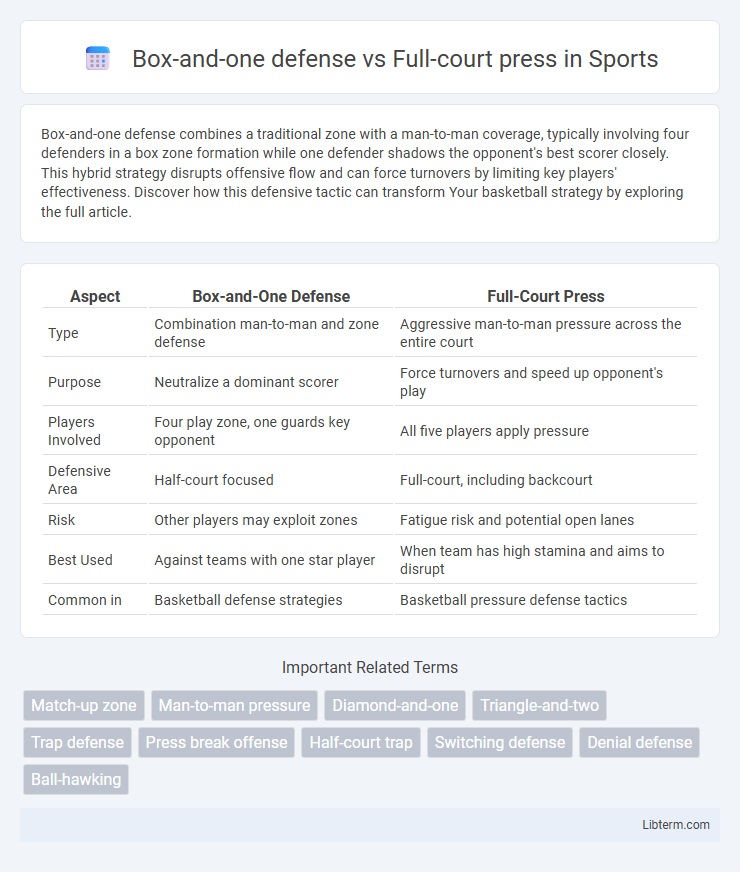Box-and-one defense combines a traditional zone with a man-to-man coverage, typically involving four defenders in a box zone formation while one defender shadows the opponent's best scorer closely. This hybrid strategy disrupts offensive flow and can force turnovers by limiting key players' effectiveness. Discover how this defensive tactic can transform Your basketball strategy by exploring the full article.
Table of Comparison
| Aspect | Box-and-One Defense | Full-Court Press |
|---|---|---|
| Type | Combination man-to-man and zone defense | Aggressive man-to-man pressure across the entire court |
| Purpose | Neutralize a dominant scorer | Force turnovers and speed up opponent's play |
| Players Involved | Four play zone, one guards key opponent | All five players apply pressure |
| Defensive Area | Half-court focused | Full-court, including backcourt |
| Risk | Other players may exploit zones | Fatigue risk and potential open lanes |
| Best Used | Against teams with one star player | When team has high stamina and aims to disrupt |
| Common in | Basketball defense strategies | Basketball pressure defense tactics |
Introduction to Box-and-One Defense and Full-Court Press
Box-and-one defense combines a zone setup with a man-to-man assignment where one defender shadows the opposing team's best scorer, disrupting offensive rhythm. Full-court press applies intense defensive pressure across the entire playing area to force turnovers and accelerate the game pace. Both defenses strategically challenge ball movement and scoring opportunities to gain a competitive edge.
Key Principles of Box-and-One Defense
The Box-and-One defense centers on four players forming a zone box to protect the paint while one defender pursues the opposing team's star player with man-to-man coverage. It emphasizes intense individual pressure on the key offensive threat combined with team communication to trap and force difficult shots. This hybrid defense exploits the opponent's reliance on one dominant scorer, disrupting their rhythm while maintaining strong interior defense.
Key Principles of Full-Court Press
The full-court press relies on aggressive, constant pressure on the offensive team from the moment they inbound the ball, aiming to force turnovers and disrupt their rhythm. Key principles include intense ball denial, trapping near the sidelines, and coordinated rotations to cover passing lanes and prevent easy breakouts. This defense requires high energy, communication, and anticipation to trap effectively while avoiding easy penetration or open shooters.
Strategic Objectives: Box-and-One vs Full-Court Press
The Box-and-One defense aims to neutralize a dominant offensive player by assigning a single defender while the other four form a box zone, optimizing perimeter control and limiting inside scoring opportunities. In contrast, the Full-Court Press applies pressure across the entire court, forcing turnovers and disrupting the opposing team's rhythm through aggressive trapping and fast-paced defense. Both strategies seek to control the game's tempo but differ in focus; the Box-and-One targets individual player limitations, whereas the Full-Court Press emphasizes team-wide defensive intensity and ball control pressure.
Player Roles and Responsibilities
In a box-and-one defense, four defenders form a tight box around the paint to protect the rim, while the fifth player shadows the opposing team's best scorer, applying intense on-ball pressure to limit scoring opportunities. The box defenders focus on help defense and rebounding, ensuring they cover passing lanes and prevent inside penetration. Against a full-court press, all five players must communicate and execute precise ball handling and passing; the primary ball-handler's role becomes critical in breaking pressure, while teammates provide spacing and support to maintain possession.
Strengths of Box-and-One Defense
The box-and-one defense excels at neutralizing a single dominant scorer by employing a dedicated defender while the other four players maintain a zone, limiting effective penetration and outside shooting. This hybrid strategy disrupts offensive rhythm and forces secondary players to create shots under pressure. Its strength lies in combining tight man-to-man coverage on the star player with collective zone tactics to protect critical scoring areas.
Strengths of Full-Court Press
The full-court press excels at applying intense defensive pressure across the entire court, forcing turnovers and disrupting offensive flow early. This strategy increases the pace of the game, often leading to rushed decisions and increased scoring opportunities for the pressing team. The continuous pressure also limits the effectiveness of the box-and-one defense by preventing the offense from setting up structured plays.
Weaknesses and Vulnerabilities
The Box-and-one defense is vulnerable to quick perimeter ball movement and effective off-ball screens, allowing the offense to exploit the single defender's focus on a key player. This defensive scheme struggles against teams with multiple strong shooters who can capitalize on the space created by the four-player box formation. In contrast, the Full-court press exposes vulnerabilities in transition defense, often leading to easy fast-break opportunities when opponents break the press with precise passing and strong ball-handling skills.
Best Situations to Implement Each Defense
Box-and-one defense excels against teams relying heavily on a single dominant scorer, allowing the box defenders to contain other players while one defender shadows the star. Full-court press is most effective when aiming to disrupt an opponent's ball handling and force turnovers early in the game, especially against teams with weaker ball handlers. Coaches often deploy box-and-one in late-game scenarios to neutralize key threats, while full-court press fits well in high-tempo or comeback situations requiring increased defensive pressure.
Choosing the Right Defense for Your Team
Choosing the right defense between Box-and-one and Full-court press depends on your team's strengths and the opponent's weaknesses. The Box-and-one effectively neutralizes a dominant scorer by combining man-to-man coverage with zone defense, ideal for teams facing a key offensive threat. Full-court press applies intense pressure across the entire court, forcing turnovers and exploiting teams with weak ball-handling and poor stamina.
Box-and-one defense Infographic

 libterm.com
libterm.com